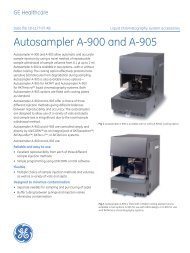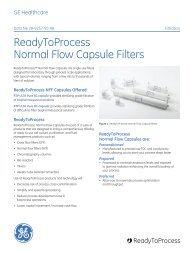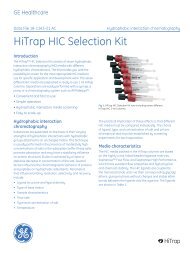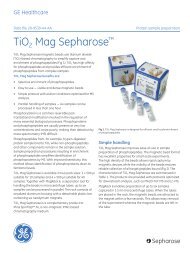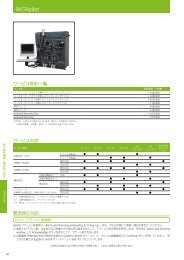[PDF] Q Sepharose High Performance and SP Sepharose High ...
[PDF] Q Sepharose High Performance and SP Sepharose High ...
[PDF] Q Sepharose High Performance and SP Sepharose High ...
Create successful ePaper yourself
Turn your PDF publications into a flip-book with our unique Google optimized e-Paper software.
GE Healthcare<br />
Data File 18-1172-88 AB Ion Exhange Chromatography<br />
Q <strong>Sepharose</strong> <strong>High</strong> <strong>Performance</strong><br />
<strong>SP</strong> <strong>Sepharose</strong> <strong>High</strong> <strong>Performance</strong><br />
Prepacked HiLoad <strong>and</strong> HiTrap columns<br />
Q <strong>Sepharose</strong> <strong>High</strong> <strong>Performance</strong> <strong>and</strong> <strong>SP</strong> <strong>Sepharose</strong> <strong>High</strong><br />
<strong>Performance</strong> enjoy well-deserved reputations as highly<br />
successful anion <strong>and</strong> cation ion exchange media for purifying<br />
a wide range of biomolecules. Both share an impressive list<br />
of operational characteristics that includes:<br />
• <strong>High</strong>-resolution, high-capacity separations with<br />
high recovery<br />
• Reliable <strong>and</strong> reproducible<br />
• <strong>High</strong> chemical stability for effective CIP/sanitization<br />
• Available in convenient HiLoad <strong>and</strong> HiTrap prepacked columns plus laboratory packs<br />
• Easy to scale up<br />
With these attributes, Q <strong>and</strong> <strong>SP</strong> <strong>Sepharose</strong> <strong>High</strong> <strong>Performance</strong><br />
occupy a central position in the broad spectrum of GE Healthcare<br />
ion exchange products. Their high resolution generates<br />
distinct, high purity separations <strong>and</strong> their high capacity<br />
<strong>and</strong> ease of use encourages preparative use <strong>and</strong> scale-up,<br />
primarily in intermediate <strong>and</strong> final purification. Availability<br />
in different prepacked HiLoad <strong>and</strong> HiTrap column formats<br />
plus laboratory packs gives users the freedom to enjoy the<br />
convenience <strong>and</strong> simplicity of ready-to-use columns or the<br />
flexibility of choosing column type <strong>and</strong> size (Fig 1).<br />
Ion exchange chromatography<br />
Ion exchange chromatography is probably the most frequently<br />
used <strong>and</strong> versatile method for fractionating biological substances,<br />
even proteins <strong>and</strong> peptides with small differences in<br />
charge can be separated. Furthermore, binding <strong>and</strong> elution<br />
conditions are easy to optimize, resulting in fast, highresolution<br />
separations that are reproducible <strong>and</strong> costeffective<br />
to scale up.<br />
imagination at work<br />
Fig 1. Q <strong>and</strong> <strong>SP</strong> <strong>Sepharose</strong> <strong>High</strong> <strong>Performance</strong>, available in lab packs<br />
<strong>and</strong> prepacked HiLoad <strong>and</strong> HiTrap columns, are a dominant force<br />
in the high-resolution, high-capacity purification of biomolecules.<br />
Charged molecules bind to the separation medium at low<br />
ionic strength <strong>and</strong> are then eluted with a salt or pH gradient.<br />
Whereas continuous gradient elution is most frequently used<br />
in high resolution ion exchange chromatography, simple<br />
stepwise gradient elution is recommended for sample<br />
preparation, concentration, etc.<br />
These factors have all contributed to making ion exchange<br />
chromatography a leading technique in biomolecule<br />
separation today. Thanks to the highly efficient, highresolution<br />
separations that Q <strong>and</strong> <strong>SP</strong> <strong>Sepharose</strong> <strong>High</strong><br />
<strong>Performance</strong> deliver, they continue to play a key role in the<br />
purification of biomolecules.
Media characteristics<br />
Q <strong>Sepharose</strong> <strong>High</strong> <strong>Performance</strong> <strong>and</strong> <strong>SP</strong> <strong>Sepharose</strong> <strong>High</strong><br />
<strong>Performance</strong> are high-resolution anion <strong>and</strong> cation exchange<br />
media based on highly cross-linked 34 µm agarose beads.<br />
This matrix provides excellent chemical <strong>and</strong> physical<br />
stability. The rigidity <strong>and</strong> small size of the particles allows<br />
fast adsorption <strong>and</strong> desorption, even at high sample<br />
loadings <strong>and</strong> flow rates.<br />
Q <strong>Sepharose</strong> <strong>High</strong> <strong>Performance</strong> is a strong anion exchange<br />
medium <strong>and</strong> <strong>SP</strong> <strong>Sepharose</strong> <strong>High</strong> <strong>Performance</strong> a strong<br />
cation exchanger. The Q functional group is a quaternary<br />
amino group <strong>and</strong> the <strong>SP</strong> sulphopropyl. Both are coupled<br />
to the matrix via chemically stable ether linkages. The two<br />
media remain charged <strong>and</strong> have high loading capacities<br />
over broad pH ranges.<br />
Table 1 lists the main media characteristics.<br />
Table 1. Main media characteristics of Q <strong>and</strong> <strong>SP</strong> <strong>Sepharose</strong> <strong>High</strong><br />
<strong>Performance</strong><br />
Matrix 6% spherical, cross-linked agarose<br />
Functional groups -CH2N + (CH3) 3, quaternary ammonium (Q)<br />
- -CH2CH2CH2SO3 , sulphopropyl (<strong>SP</strong>)<br />
Total ionic capacity 0.14 to 0.20 mmol (Cl- )/ml medium (Q)<br />
0.15 to 0.20 mmol (H + )//ml medium (<strong>SP</strong>)<br />
Binding capacity 70 mg BSA/ml medium (Q)<br />
55 mg ribonuclease A/ml medium (<strong>SP</strong>)<br />
Average particle size 34 µm<br />
Exclusion limit 4 x 106 daltons (globular proteins)<br />
Rec. linear flow rate Up to 150 cm/h<br />
Chemical stability 1 M sodium hydroxide<br />
1 M acetic acid<br />
8 M urea<br />
6 M guanidine hydrochloride<br />
30% acetonitrile<br />
30% isopropanol<br />
70% ethanol<br />
2% SDS<br />
pH stability<br />
short term1 1 to 14 (Q), 3 to 14 (<strong>SP</strong>)<br />
long term <strong>and</strong> working 2 2 to 12 (Q), 4 to 13 (<strong>SP</strong>)<br />
Storage 20% ethanol (Q)<br />
20% ethanol, 0.2 M sodium acetate (<strong>SP</strong>)<br />
1 Refers to the pH interval for regeneration<br />
2 Refers to the pH interval where the medium is stable over a long period of time<br />
without adverse effects on its subsequent chromatographic performance<br />
2 Data File 18-1172-88 AB<br />
Packing in laboratory columns<br />
Q <strong>and</strong> <strong>SP</strong> <strong>Sepharose</strong> <strong>High</strong> <strong>Performance</strong> are supplied in laboratory<br />
packs of 75 ml, which is ideal for users who prefer the flexibility<br />
of packing columns of their choice. Straightforward <strong>and</strong><br />
well-proven recommendations for packing, operation <strong>and</strong><br />
maintenance are included in the instructions.<br />
Empty high-resolution columns from the Tricorn <strong>and</strong> XK<br />
ranges are available in a variety of sizes <strong>and</strong> recommended<br />
for users who want to pack their own columns.<br />
Prepacked Q <strong>and</strong> <strong>SP</strong> <strong>Sepharose</strong> <strong>High</strong><br />
<strong>Performance</strong> columns<br />
By providing added speed, convenience <strong>and</strong> reproducibility,<br />
prepacked columns extend the usefulness of Q <strong>and</strong> <strong>SP</strong><br />
<strong>Sepharose</strong> <strong>High</strong> <strong>Performance</strong>. ÄKTAdesign system includes<br />
preset method templates based on these prepacked<br />
columns, which further improves convenience <strong>and</strong> results,<br />
particularly their reproducibility, plus the speed at which<br />
they are achieved.<br />
Both media are supplied in two types of column, each<br />
available in two sizes; HiLoad Q <strong>and</strong> <strong>SP</strong> <strong>Sepharose</strong> <strong>High</strong><br />
<strong>Performance</strong>, <strong>and</strong> HiTrap Q HP <strong>and</strong> <strong>SP</strong> HP.<br />
HiLoad 16/10 <strong>and</strong> 26/10 Q <strong>Sepharose</strong><br />
<strong>High</strong> <strong>Performance</strong><br />
HiLoad 16/10 <strong>and</strong> 26/10 <strong>SP</strong> <strong>Sepharose</strong><br />
<strong>High</strong> <strong>Performance</strong><br />
HiLoad prepacked columns are XK laboratory columns<br />
prepacked with Q or <strong>SP</strong> <strong>Sepharose</strong> <strong>High</strong> <strong>Performance</strong>.<br />
XK columns are the perfect partners for preparative<br />
separations with <strong>Sepharose</strong> <strong>High</strong> <strong>Performance</strong>. The<br />
columns have an advanced design <strong>and</strong> are constructed<br />
from precision bore borosilicate glass. Dead volumes are<br />
less than 0.1% of the total column volume. A thermostatic<br />
jacket is fitted as st<strong>and</strong>ard. HiLoad Q <strong>and</strong> <strong>SP</strong> <strong>Sepharose</strong><br />
<strong>High</strong> <strong>Performance</strong> are available in two sizes, 16 or 26 mm<br />
diameter, both with a bed height of 10 cm (Fig 1) <strong>and</strong> giving<br />
column volumes of 20 ml <strong>and</strong> 53 ml, respectively.<br />
In addition to the built-in benefits of high-resolution, highcapacity<br />
preparative separations, HiLoad columns offer<br />
great reproducibility <strong>and</strong> convenience. Every HiLoad column<br />
is packed under stringent control <strong>and</strong> tested individually for<br />
bed volume, efficiency (theoretical plates/m), asymmetry<br />
factor, <strong>and</strong> flow characteristics. They can be used in a<br />
variety of systems, such as ÄKTAdesign. Flanged tubing <strong>and</strong><br />
M6 connectors for connection to FPLC System are supplied<br />
as st<strong>and</strong>ard, as are connectors for ÄKTAdesign systems.<br />
Table 2 lists the key characteristics of HiLoad 16/10 <strong>and</strong><br />
26/10 Q <strong>and</strong> <strong>SP</strong> <strong>Sepharose</strong> <strong>High</strong> <strong>Performance</strong> columns.
Table 2. HiLoad Q <strong>and</strong> <strong>SP</strong> <strong>Sepharose</strong> <strong>High</strong> <strong>Performance</strong> column<br />
characteristics. See Table 1 for media characteristics.<br />
Bed diameter 16 or 26 mm<br />
Bed height 10 cm<br />
Bed volume 20 ml (16/10)<br />
53 ml (26/10)<br />
Theoretical plates >12 000 /m<br />
Rec. flow rate up to 150 cm/h (5 ml/min for<br />
16/10, 13 ml/min for 26/10)<br />
Max. back pressure over the 0.3 MPa, 3 bar, 42 psi<br />
packed bed during operation<br />
HiLoad column hardware 0.5 MPa, 5 bar, 73 psi<br />
pressure limit<br />
Storage 20% ethanol (Q)<br />
20% ethanol, 0.2 M sodium acetate (<strong>SP</strong>)<br />
HiTrap Q HP 1 ml <strong>and</strong> 5 ml<br />
HiTrap <strong>SP</strong> HP 1 ml <strong>and</strong> 5 ml<br />
HiTrap Q HP <strong>and</strong> HiTrap <strong>SP</strong> HP are small, prepacked columns<br />
made of biocompatible polypropylene. The column is delivered<br />
with a stopper on the inlet <strong>and</strong> a snap-off end on the outlet.<br />
All necessary connectors are included for connection to<br />
different systems as well as to a laboratory pump <strong>and</strong> a<br />
simple syringe. Note that HiTrap columns cannot be opened<br />
or repacked. Two sizes are available, 1 ml <strong>and</strong> 5 ml (Fig 1).<br />
The 1-ml column is often used for method screening to<br />
quickly establish optimal binding <strong>and</strong> elution conditions for<br />
specific applications. Its fast <strong>and</strong> simple operation is well-suited<br />
to this role, as well as to small-scale purifications. The larger<br />
5-ml column is an excellent choice for group separations<br />
<strong>and</strong> sample concentration, <strong>and</strong> when the purification<br />
method has been established <strong>and</strong> larger amounts of protein<br />
need to be purified. Two or three columns can be connected<br />
in series. Further scale-up can be done on HiLoad Q or <strong>SP</strong><br />
<strong>Sepharose</strong> <strong>High</strong> <strong>Performance</strong> columns (see Applications).<br />
Table 3. Characteristics of HiTrap Q HP <strong>and</strong> HiTrap <strong>SP</strong> HP.<br />
See Table 1 for media characteristics.<br />
Column dimensions 0.7 x 2.5 cm (1 ml), 1.6 x 2.5 cm (5 ml)<br />
Column volumes 1 ml <strong>and</strong> 5 ml<br />
Rec. flow rate 1.0 ml/min (1 ml), 5.0 ml/min (5 ml)<br />
Max. flow rate* 4.0 ml/min (1 ml), 20.0 ml/min (5 ml)<br />
Max. back pressure 0.3 MPa, 3 bar, 42 psi<br />
Storage 20% ethanol (Q)<br />
20% ethanol, 0.2 M sodium acetate (<strong>SP</strong>)<br />
* Room temperature, aqueous buffers<br />
Operating HiTrap Q HP <strong>and</strong> HiTrap <strong>SP</strong> HP<br />
Using HiTrap Q HP <strong>and</strong> HiTrap <strong>SP</strong> HP prepacked columns is<br />
simple. Complete, easy-to-follow instructions are included<br />
for fast start-up <strong>and</strong> method optimization. Whether you use<br />
a syringe <strong>and</strong> the provided luer adaptor (Fig. 2), a peristaltic<br />
pump, or a chromatography system such as ÄKTA design or<br />
FPLC System, operation is straightforward.<br />
Related media available in HiTrap IEX<br />
Selection Kit<br />
Although it does not include Q or <strong>SP</strong> <strong>Sepharose</strong> <strong>High</strong><br />
<strong>Performance</strong> media, the HiTrap IEX Selection Kit will be of<br />
interest to many potential users of these two ion exchangers.<br />
The kit consists of seven different ion exchange media<br />
prepacked in HiTrap 1 ml columns; <strong>SP</strong> <strong>Sepharose</strong> Fast Flow,<br />
Q <strong>Sepharose</strong> Fast Flow, DEAE <strong>Sepharose</strong> Fast Flow,<br />
CM <strong>Sepharose</strong> Fast Flow, ANX <strong>Sepharose</strong> 4 Fast Flow (high sub),<br />
<strong>SP</strong> <strong>Sepharose</strong> XL <strong>and</strong> Q <strong>Sepharose</strong> XL.<br />
A<br />
B<br />
C<br />
Fig 2. Using a HiTrap Q HP or HiTrap <strong>SP</strong> HP 1 ml column with a syringe.<br />
A Prepare buffers <strong>and</strong> sample. Remove stop plug from top<br />
of the column <strong>and</strong> snap off the end. Equilibrate.<br />
B Load the sample <strong>and</strong> begin collecting fractions.<br />
C Wash, elute <strong>and</strong> continue collecting fractions.<br />
Data File 18-1172-88 AB 3
The HiTrap IEX Selection Kit offers a fast, simple <strong>and</strong> convenient<br />
way to decide which ion exchange matrix <strong>and</strong> lig<strong>and</strong> is best<br />
for a given application. In other words, it is a useful tool in<br />
helping speed the development of an optimized ion exchange<br />
separation.<br />
The seven columns included in the kit are also available as<br />
individual HiTrap 1-ml <strong>and</strong> 5-ml columns. For more information<br />
about the kit, request Data File HiTrap IEX Selection Kit,<br />
Code no. 18-1140-48.<br />
Chemical stability<br />
Good chemical stability allows the use of effective cleaningin-place<br />
(CIP) schemes that result in high recoveries<br />
over many purification cycles. Likewise, it allows regular<br />
sanitization to hinder microbial growth <strong>and</strong> maintain a high<br />
level of hygiene. Both CIP <strong>and</strong> sanitization thus promote good<br />
economy <strong>and</strong> are therefore key factors to consider when<br />
selecting ion exchange media <strong>and</strong> prepacked columns for<br />
preparative applications.<br />
For CIP, regular washing with 0.5 to 1.0 M sodium hydroxide<br />
should be sufficient to remove most contaminating material,<br />
although very hydrophobic molecules may bind so tightly<br />
that they must be eluted with organic solvents agents like<br />
70% ethanol or 30% isopropanol, or with strong detergents.<br />
CIP <strong>and</strong> sanitization protocols for Q <strong>and</strong> <strong>SP</strong> <strong>Sepharose</strong><br />
<strong>High</strong> <strong>Performance</strong> are included in the packages. Note that<br />
specific protocols should be developed according to the<br />
nature <strong>and</strong> condition of the starting material.<br />
Recommeded buffers for anion exchange chromatography.<br />
Recommeded buffers for cation exchange chromatography.<br />
Fig 3. Recommeded buffers for ion exchange chromatography.<br />
4 Data File 18-1172-88 AB<br />
Table 4. Recommended volatile buffers for ion exchange<br />
chromatography<br />
pH Volatile buffer systems<br />
2.3–3.5 Pyridine/formic acid<br />
3.0–5.0 Trimethylamine/formic acid<br />
4.0–6.0 Trimethylamine/acetic acid<br />
6.8–8.8 Trimethylamine/HCl<br />
7.0–8.5 Ammonia/formic acid<br />
8.5–10.0 Ammonia/acetic acid<br />
7.0–12.0 Trimethylamine/CO2<br />
8.0–9.5 Ammonium carbonate/ammonia<br />
8.5–10.5 Ethanolamine/HCl<br />
Applications<br />
Protein <strong>and</strong> nucleic acid purifications<br />
The applications of Q <strong>and</strong> <strong>SP</strong> <strong>Sepharose</strong> <strong>High</strong> <strong>Performance</strong><br />
are many. The extreme versatility of ion exchange plus the<br />
performance benefit of high resolution with high capacity<br />
make both media a natural choice for preparative separations<br />
during the intermediate <strong>and</strong> final steps of a purification<br />
scheme. The excellent availability of suitable equipment<br />
also contributes to widespread use, especially as systems in<br />
the ÄKTAdesign platform have ready-programmed method<br />
templates for both HiLoad <strong>and</strong> HiTrap columns.<br />
Figure 6 shows the separation of st<strong>and</strong>ard proteins when<br />
scaling-up on HiLoad 16/10 <strong>and</strong> HiLoad 26/10 <strong>SP</strong> <strong>Sepharose</strong><br />
<strong>High</strong> <strong>Performance</strong>. Figure 4 shows a DNA application, the<br />
purification of supercoiled plasmid DNA on HiLoad 16/10<br />
Q <strong>Sepharose</strong> <strong>High</strong> <strong>Performance</strong> resulting in 220 µg of<br />
biologically active material.<br />
Column: HiLoad 16/10 Q <strong>Sepharose</strong> <strong>High</strong> <strong>Performance</strong><br />
Sample: 2.0 ml of a bacterial alkaline extract of HB 101 (pBR322)<br />
corresponding to 400 ml amplified bacterial culture<br />
Start buffer: 10 mM Tris-HCl, 1 mM EDTA, 0.7 M NaCI, pH 8.0<br />
Elution buffer: 10 mM Tris-HCl, 1 mM EDTA, 0.85 M NaCI, pH 8.0<br />
Flow rate: 3 ml/min (90 cm/h)<br />
Result: 220 µg biologically active supercoiled DNA<br />
A 254 nm<br />
0.2<br />
0.1<br />
CCC<br />
0<br />
50 100 150 200 250 300 350 400<br />
Volume (ml)<br />
Fig 4. Purification of supercoiled plasmid DNA on HiLoad 16/10 Q<br />
<strong>Sepharose</strong> <strong>High</strong> <strong>Performance</strong>.<br />
OC
Group separation <strong>and</strong> sample concentration<br />
The 1-ml <strong>and</strong> 5-ml HiTrap columns complement the other Q<br />
<strong>and</strong> <strong>SP</strong> <strong>Sepharose</strong> <strong>High</strong> <strong>Performance</strong> products by providing<br />
rapid <strong>and</strong> reliable method scouting as well as group separation<br />
<strong>and</strong> sample concentration. Figures 5A <strong>and</strong> B illustrate an<br />
example of group separation on HiTrap <strong>SP</strong> HP 1 ml <strong>and</strong><br />
SDS-PAGE analysis of the fractions respectively.<br />
Sample concentration is frequently required to improve<br />
subsequent purification steps. For example, concentration<br />
is necessary prior to gel filtration to reduce sample volume,<br />
which is one of the more important factors affecting<br />
resolution with this technique.<br />
Table 5 shows the efficiency of HiTrap Q HP 1 ml <strong>and</strong><br />
HiTrap <strong>SP</strong> HP 5 ml for concentrating st<strong>and</strong>ard proteins.<br />
Samples were dissolved in start buffer <strong>and</strong> applied to the<br />
columns at flow rates of 0.5 ml/min (HiTrap Q HP) <strong>and</strong> 2.5 ml/min<br />
(HiTrap <strong>SP</strong> HP) with a peristaltic pump. Columns were then<br />
washed with start buffer <strong>and</strong> eluted with elution buffer using<br />
a syringe. Fractions were collected for analysis <strong>and</strong> yield was<br />
determined by measuring absorbance at 280 nm.<br />
As can be seen, yields are high, even for very dilute samples.<br />
After concentration, the sample is eluted in volumes suitable<br />
for direct loading onto gel filtration columns, e.g. prepacked<br />
HiLoad 16/60 or 26/60 Superdex 30 prep grade, 75 prep<br />
grade, or 200 prep grade.<br />
Initial scale-up<br />
HiTrap columns also offer a quick start to scaled-up<br />
purifications, either by two or three HiTrap columns being<br />
connected in series, or by progressing to larger HiLoad columns.<br />
Figure 6 shows the scale-up of a st<strong>and</strong>ard protein mixture<br />
on different sizes of HiTrap (1 ml <strong>and</strong> 5 ml) <strong>and</strong> HiLoad<br />
(20 ml <strong>and</strong> 53 ml) columns. Flow rate (ml/min) was scaled<br />
according to the ratio between the cross-sectional areas<br />
of the columns, <strong>and</strong> gradient length <strong>and</strong> sample loading<br />
according to the ratio between the column volumes.<br />
The reproducibility of the separation result confirms how<br />
easy this scale-up strategy is to apply in practice.<br />
Process development <strong>and</strong> scale-up to production<br />
The excellent performance of Q <strong>and</strong> <strong>SP</strong> <strong>Sepharose</strong> <strong>High</strong><br />
<strong>Performance</strong> for laboratory scale preparative applications<br />
naturally lends itself to the process development <strong>and</strong><br />
scale-up of ion exchange separations. The media are well<br />
supported for this task.<br />
As members of the BioProcess family, both are backed up<br />
with special services <strong>and</strong> documentation to facilitate the<br />
development, scale-up <strong>and</strong> routine operation of production<br />
applications. Validated manufacture, secure supply <strong>and</strong><br />
regulatory support comprise just part of this package.<br />
For more information, please contact GE Healthcare.<br />
Column: HiTrap <strong>SP</strong> HP, 1 ml<br />
Sample: Casein-precipitated human milk, filtered (0.45 µm filter) <strong>and</strong><br />
buffer exchanged to start buffer on a PD-10 Desalting column<br />
Sample volume: 0.5 ml<br />
Flow rate: 1.0 ml/min (150 cm/h)<br />
Start buffer: 50 mM sodium acetate, pH 6.0<br />
Elution buffer: 50 mM sodium acetate, 1.0 M NaCl, pH 6.0<br />
A 280nm<br />
0.5<br />
0.4<br />
0.3<br />
0.2<br />
0.1<br />
0<br />
Fraction 2<br />
10%<br />
16 17<br />
Fig 5A. Group separation of proteins from casein-precipitated<br />
human milk on HiTrap <strong>SP</strong> HP 1 ml.<br />
M r<br />
97 000<br />
66 000<br />
45 000<br />
30 000<br />
20 100<br />
14 400<br />
Fraction 9<br />
40%<br />
24<br />
100% Elution Buffer<br />
5 10 15 20 25 30<br />
Volume (ml)<br />
Lane 1: LMW markers<br />
Lane 2: Start material, casein-precipitated human milk, diluted 5x<br />
Lane 3: Fraction 2, diluted 2x<br />
Lane 4: Fraction 9<br />
Lane 5: Fraction 16<br />
Lane 6: Fraction 17<br />
Lane 7: Fraction 24<br />
Fig 5B. SDS electrophoresis (PhastSystem , PhastGel 10–15,<br />
silver staining) on fractions from the group separation of caseinprecipitated<br />
human milk on HiTrap <strong>SP</strong> HP 1 ml shown in Fig. 5A.<br />
Data File 18-1172-88 AB 5
Table 5. HiTrap Q HP 1 ml <strong>and</strong> HiTrap <strong>SP</strong> HP 5 ml used for concentrating st<strong>and</strong>ard proteins. Note the high yields, even for very dilute samples.<br />
Sample Sample Eluted Volume Conc.<br />
conc. volume conc. eluted factor<br />
Column Sample µg/ml ml µg/ml ml (volume) Yield %<br />
HiTrap Q HP, 1 ml Human IgG 23 450 3180 3.0 150 92<br />
10 100 4700 2.0 50 93<br />
1010 10 3370 3.0 3 100<br />
HiTrap <strong>SP</strong> HP, 5 ml Lysozyme 333 150 3170 16.0 9 100<br />
33 1500 3720 13.2 114 98<br />
HiTrap <strong>SP</strong> HP, 1 ml<br />
Sample: Concanavalin A, ribonuclease A, α-chymotrypsinogen A,<br />
lysozyme, 4 mg protein/ml (3:3:1:1) in start buffer<br />
Sample load: 1 mg protein/ml medium<br />
Sample volume: 0.25 ml, 25% of column volume<br />
Column volume: 1 ml<br />
Flow rate: 0.5 ml/min (75 cm/h)<br />
Start buffer: 50 mM MES, pH 6.0<br />
Elution buffer: 50 mM MES, 1.0 M NaCl, pH 6.0<br />
Gradient: –43% elution buffer over 10 ml (10 column volumes)<br />
0.14<br />
0.12<br />
0.10<br />
0.08<br />
0.06<br />
0.04<br />
0.02<br />
0<br />
A 280nm<br />
HiLoad 16/10 <strong>SP</strong> <strong>Sepharose</strong> <strong>High</strong> <strong>Performance</strong><br />
Sample: Concanavalin A, ribonuclease A, α-chymotrypsinogen A,<br />
lysozyme, 4 mg protein/ml (3:3:1:1) in start buffer<br />
Sample load: 1 mg protein/ml medium<br />
Sample volume: 5.0 ml, 25% of column volume<br />
Column volume: 20 ml<br />
Flow rate: 2.5 ml/min (75 cm/h)<br />
Start buffer: 50 mM MES, pH 6.0<br />
Elution buffer: 50 mM MES, 1.0 M NaCl, pH 6.0<br />
Gradient: 0–43% elution buffer over 200 ml (10 column volumes)<br />
0.16<br />
0.14<br />
0.12<br />
0.10<br />
0.08<br />
0.06<br />
0.04<br />
0.02<br />
A 280nm<br />
0<br />
A 280<br />
6 Data File 18-1172-88 AB<br />
Conductivity<br />
2 4 6 8 10 12 14 16 ml<br />
A 280<br />
Conductivity<br />
40 80 120 160 200 240 280 320 ml<br />
HiTrap <strong>SP</strong> HP, 5 ml<br />
Sample: Concanavalin A, ribonuclease A, α-chymotrypsinogen A,<br />
lysozyme, 4 mg protein/ml (3:3:1:1) in start buffer<br />
Sample load: 1 mg protein/ml medium<br />
Sample volume: 1.25 ml, 25% of column volume<br />
Column volume: 5 ml<br />
Flow rate: 2.5 ml/min (75 cm/h)<br />
Start buffer: 50 mM MES, pH 6.0<br />
Elution buffer: 50 mM MES, 1.0 M NaCl, pH 6.0<br />
Gradient: 0–43% elution buffer over 50 ml (10 column volumes)<br />
0.14<br />
0.12<br />
0.10<br />
0.08<br />
0.06<br />
0.04<br />
0.02<br />
0<br />
A 280nm<br />
A 280<br />
Conductivity<br />
10 20 30 40 50 60 70 80 ml<br />
HiLoad 26/10 <strong>SP</strong> <strong>Sepharose</strong> <strong>High</strong> <strong>Performance</strong><br />
Sample: Concanavalin A, ribonuclease A, α-chymotrypsinogen A,<br />
lysozyme, 4 mg protein/ml (3:3:1:1) in start buffer<br />
Sample load: 1 mg protein/ml medium<br />
Sample volume: 13.25 ml, 25% of column volume<br />
Column volume: 53 ml<br />
Flow rate: 6.6 ml/min (75 cm/h)<br />
Start buffer: 50 mM MES, pH 6.0<br />
Elution buffer: 50 mM MES, 1.0 M NaCl, pH 6.0<br />
Gradient: 0–43% elution buffer over 530 ml (10 column volumes)<br />
0.14<br />
0.12<br />
0.10<br />
0.08<br />
0.06<br />
0.04<br />
0.02<br />
0<br />
A 280nm<br />
A 280<br />
Conductivity<br />
100 200 300 400 500 600 700 800 ml<br />
Fig 6. Comparing separations on HiTrap <strong>SP</strong> HP 1 ml <strong>and</strong> 5 ml <strong>and</strong> HiLoad 16/10 <strong>and</strong> 26/10 <strong>SP</strong> <strong>Sepharose</strong> <strong>High</strong> <strong>Performance</strong> columns<br />
confirms the predictable nature of the results <strong>and</strong> the ease with which separations can be scaled up.
Ordering information<br />
Products Quantity Code no.<br />
Q <strong>Sepharose</strong> <strong>High</strong> <strong>Performance</strong> 75 ml 17-1014-01<br />
Q <strong>Sepharose</strong> <strong>High</strong> <strong>Performance</strong> 1 L 17-1014-03<br />
Q <strong>Sepharose</strong> <strong>High</strong> <strong>Performance</strong> 5 L 17-1014-04<br />
Q <strong>Sepharose</strong> <strong>High</strong> <strong>Performance</strong> 10 L 17-1014-05<br />
<strong>SP</strong> <strong>Sepharose</strong> <strong>High</strong> <strong>Performance</strong> 75 ml 17-1087-01<br />
<strong>SP</strong> <strong>Sepharose</strong> <strong>High</strong> <strong>Performance</strong> 1 L 17-1087-03<br />
<strong>SP</strong> <strong>Sepharose</strong> <strong>High</strong> <strong>Performance</strong> 5 L 17-1087-04<br />
<strong>SP</strong> <strong>Sepharose</strong> <strong>High</strong> <strong>Performance</strong> 10 L 17-1087-05<br />
Prepacked columns<br />
HiLoad 16/10 Q <strong>Sepharose</strong> <strong>High</strong> 1 (20 ml) 17-1064-01<br />
<strong>Performance</strong><br />
HiLoad 26/10 Q <strong>Sepharose</strong> <strong>High</strong> 1 (53 ml) 17-1066-01<br />
<strong>Performance</strong><br />
HiLoad 16/10 <strong>SP</strong> <strong>Sepharose</strong> <strong>High</strong> 1 (20 ml) 17-1137-01<br />
<strong>Performance</strong><br />
HiLoad 26/10 <strong>SP</strong> <strong>Sepharose</strong> <strong>High</strong> 1 (53 ml) 17-1138-01<br />
<strong>Performance</strong><br />
HiTrap Q HP 5 x 1 ml 17-1153-01<br />
HiTrap Q HP 5 x 5 ml 17-1154-01<br />
HiTrap <strong>SP</strong> HP 5 x 1 ml 17-1151-01<br />
HiTrap <strong>SP</strong> HP 5 x 5 ml 17-1152-01<br />
HiTrap IEX Selection Kit 7 x 1 ml 17-6002-33<br />
Related products<br />
Ion Exchange Chromatography <strong>and</strong> 11-0004-21<br />
Chromatofocusing H<strong>and</strong>book, Principles & Methods<br />
Ion Exchange Columns <strong>and</strong> Media, Product Profile 18-1127-31<br />
Convenient Protein Purification, 18-1129-81<br />
HiTrap Column Guide<br />
Column Packing CD, “The Movie” 18-1165-33<br />
HiLoad accessories No. Supplied Code no.<br />
To connect HiLoad columns to ÄKTAdesign<br />
Union M6 female/1/16” male* 5 18-3858-01<br />
Transport syringe 1 18-1017-61<br />
Domed nut 4 18-2450-01<br />
* Two unions are included in the HiLoad package<br />
HiTrap accessories<br />
1/16” male/luer female 1 2 18-1112-51<br />
Tubing connector 2 18-1003-68<br />
flangeless/M6 female 1<br />
Tubing connector 2 18-1017-98<br />
flangeless/M6 male 1<br />
Union 1/16” female/M6 male 1 6 18-1112-57<br />
Union M6 female /1/16” male 1 5 18-3858-01<br />
Union luerlock female/M6 female 2 18-1027-12<br />
HiTrap/HiPrep, 1/16” male 8 28-4010-81<br />
connector for ÄKTAdesign<br />
Stop plug female, 1/16” 2 5 11-0004-64<br />
Fingertight stop plug, 1/16” 3 5 11-0003-55<br />
1 One connector included in each HiTrap package<br />
2 Two, five, or seven stop plugs female included in HiTrap packages depending on the product<br />
3 One fingertight stop plug is connected to the top of each HiTrap column at delivery<br />
Data File 18-1172-88 AB 7
www.gehealthcare.com/protein-purification<br />
www.gehealthcare.com/hitrap<br />
www.gehealthcare.com<br />
GE Healthcare Bio-Sciences AB<br />
Björkgatan 30<br />
751 84 Uppsala<br />
Sweden<br />
ÄKTAdesign, BioProcess, Tricorn, FPLC, HiLoad, HiTrap, PhastGel,<br />
PhastSystem, <strong>Sepharose</strong>, Superdex, <strong>and</strong> Drop Design are<br />
trademarks of GE Healthcare companies. GE, imagination at work<br />
<strong>and</strong> GE monogram are trademarks of general Electric Company.<br />
All goods <strong>and</strong> services are sold subject to the terms <strong>and</strong><br />
conditions of sale of the company within GE Healthcare which<br />
supplies them. GE Healthcare reserves the right, subject to any<br />
regulatory <strong>and</strong> contractual approval, if required, to make changes<br />
in specifications <strong>and</strong> features shown herein, or discontinue the<br />
product described at any time without notice or obligation.<br />
© 2006 General Electric Company – All rights reserved.<br />
GE Healthcare Bio-Sciences AB, a General Electric Company.<br />
GE Healthcare Bio-Sciences AB<br />
Björkgatan 30, 751 84 Uppsala, Sweden<br />
GE Healthcare Europe GmbH<br />
Munzinger Strasse 5, D-79111 Freiburg, Germany<br />
GE Healthcare UK Ltd<br />
Amersham Place,<br />
Little Chalfont,<br />
Buckinghamshire, HP7 9NA, UK<br />
GE Healthcare Bio-Sciences Corp<br />
800 Centennial Avenue,<br />
P.O. Box 1327,<br />
Piscataway, NJ 08855-1327, USA<br />
GE Healthcare Bio-Sciences KK<br />
Sanken Bldg. 3-25-1,<br />
Hyakunincho, Shinjuku-ku,<br />
Tokyo 169-0073, Japan<br />
Asia Pacific Tel +65 6275 1830 Fax +65 6275 1829 • Australasia Tel +61 2 9899 0999 Fax +61 2 9899 7511 • Austria Tel 01/57606-1619 Fax 01/57606-1627 • Belgium Tel 0800 73 888 Fax 02 416 82 06<br />
Canada Tel 800 463 5800 Fax 800 567 1008 • Central, East, & South East Europe Tel +43 1 972720 Fax +43 1 97272 2750 • Denmark Tel 45 16 2400 Fax 45 16 2424 • Finl<strong>and</strong> & Baltics Tel +358 (0)9 512 39 40<br />
Fax +358 (0)9 512 39 439 • France Tel 01 69 35 67 00 Fax 01 69 41 96 77 Germany Tel 089 96281 660 Fax 089 96281 620 • Greater China Tel +852 2100 6300 Fax +852 2100 6338 • Italy Tel 02 27322 1<br />
Fax 02 27302 212 • Japan Tel +81 3 5331 9336 Fax +81 3 5331 9370 • Latin America Tel +55 11 3933 7300 Fax +55 11 3933 7304 Middle East & Africa Tel +30 210 9600 687 Fax +30 210 9600 693 • Netherl<strong>and</strong>s<br />
Tel 0800 82 82 82 1 Fax 0800 82 82 82 4 • Norway Tel 815 65 555 Fax 815 65 666 • Portugal Tel 21 417 7035 Fax 21 417 3184 • Russia & other C.I.S. & N.I.S Tel +7 (495) 956 5177 Fax +7 (495) 956 5176 • Spain<br />
Tel 93 594 49 50 Fax 93 594 49 55 • Sweden Tel 018 612 1900 Fax 018 612 1910 • Switzerl<strong>and</strong> Tel 0848 8028 12 Fax 0848 8028 13 • UK Tel 0800 616928 Fax 0800 616927 • USA Tel 800 526 3593 Fax 877 295 8102<br />
imagination at work<br />
18-1172-88 AB 04/2006


![[PDF] Q Sepharose High Performance and SP Sepharose High ...](https://img.yumpu.com/12314010/1/500x640/pdf-q-sepharose-high-performance-and-sp-sepharose-high-.jpg)
![[PDF] マニュアル GradiFrac](https://img.yumpu.com/22037825/1/190x253/pdf-gradifrac.jpg?quality=85)
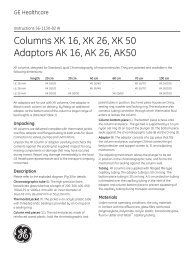
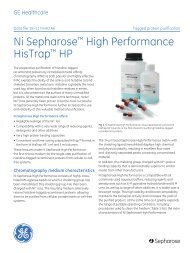
![[PDF] Sample preparation for analysis of protein, peptides and ...](https://img.yumpu.com/21549715/1/190x257/pdf-sample-preparation-for-analysis-of-protein-peptides-and-.jpg?quality=85)
![[PDF] Data File: rProtein A Sepharose Fast Flow](https://img.yumpu.com/21549316/1/190x253/pdf-data-file-rprotein-a-sepharose-fast-flow.jpg?quality=85)
![[PDF] MBP-tagged protein purification](https://img.yumpu.com/21548507/1/184x260/pdf-mbp-tagged-protein-purification.jpg?quality=85)
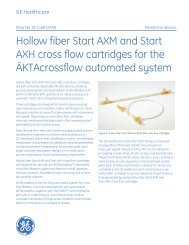
![[PDF] AKTA ready system Data file](https://img.yumpu.com/21540925/1/190x253/pdf-akta-ready-system-data-file.jpg?quality=85)
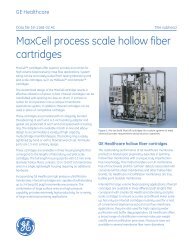
![[PDF] Data File - rProtein A/Protein G GraviTrap](https://img.yumpu.com/21539052/1/190x253/pdf-data-file-rprotein-a-protein-g-gravitrap.jpg?quality=85)
